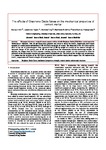The effects of Graphene Oxide flakes on the mechanical properties of cement mortar
| dc.contributor.author | Kim, B | |
| dc.date.accessioned | 2018-03-05T12:29:25Z | |
| dc.date.accessioned | 2018-07-06T10:30:24Z | |
| dc.date.available | 2018-03-05T12:29:25Z | |
| dc.date.issued | 2018-03 | |
| dc.identifier.issn | 1598-8198 | |
| dc.identifier.issn | 1598-818X | |
| dc.identifier.uri | http://hdl.handle.net/10026.1/11811 | |
| dc.description.abstract |
This paper discusses a study of cement mortar reinforced with Graphene Oxide (GO) flakes carried out at the University of Plymouth. Over 60 specimens were prepared and tested to obtain the tensile, compressive and flexural strengths of cement mortar with/without 0.5% GO flakes by weight of cement. The dispersion of the GO flakes and the effect of the use of polycarboxylate ether superplasticizer (0.2% by weight of cement) on the material strength are discussed. Images of the particle sizes of GO are presented from the transmission electron microscopy analysis. In addition, the images from the field emission scanning electron microscope analysis are also presented to show the difference of the microscopic structure of cement mortar with/without GO. The results of the strength tests are presented. It is shown that the inclusion of the GO flakes in general led to positive results, which suggest that GO improved the tensile, compressive and flexural strengths of cement mortar. | |
| dc.format.extent | 261-267 | |
| dc.language.iso | en | |
| dc.publisher | Techno-press | |
| dc.relation.replaces | http://hdl.handle.net/10026.1/10927 | |
| dc.relation.replaces | 10026.1/10927 | |
| dc.relation.replaces | 10026.1/11782 | |
| dc.relation.replaces | http://hdl.handle.net/10026.1/11782 | |
| dc.subject | Graphene Oxide flakes | |
| dc.subject | mechanical properties | |
| dc.subject | strength | |
| dc.subject | cement mortar | |
| dc.subject | microscopic structure | |
| dc.title | The effects of Graphene Oxide flakes on the mechanical properties of cement mortar | |
| dc.type | journal-article | |
| dc.type | Article | |
| plymouth.author-url | https://www.webofscience.com/api/gateway?GWVersion=2&SrcApp=PARTNER_APP&SrcAuth=LinksAMR&KeyUT=WOS:000429258700004&DestLinkType=FullRecord&DestApp=ALL_WOS&UsrCustomerID=11bb513d99f797142bcfeffcc58ea008 | |
| plymouth.issue | 3 | |
| plymouth.volume | 21 | |
| plymouth.publication-status | Published | |
| plymouth.journal | Computers and Concrete | |
| dc.identifier.doi | 10.12989/cac.2018.21.3.261 | |
| pubs.merge-from | 10026.1/11782 | |
| pubs.merge-from | http://hdl.handle.net/10026.1/11782 | |
| plymouth.organisational-group | /Plymouth | |
| plymouth.organisational-group | /Plymouth/Faculty of Science and Engineering | |
| plymouth.organisational-group | /Plymouth/REF 2021 Researchers by UoA | |
| plymouth.organisational-group | /Plymouth/REF 2021 Researchers by UoA/UoA12 Engineering | |
| plymouth.organisational-group | /Plymouth/Users by role | |
| plymouth.organisational-group | /Plymouth/Users by role/Academics | |
| dcterms.dateAccepted | 2017-12-06 | |
| dc.rights.embargodate | 2019-3-1 | |
| dc.identifier.eissn | 1598-818X | |
| dc.rights.embargoperiod | Not known | |
| rioxxterms.version | Accepted Manuscript | |
| rioxxterms.versionofrecord | 10.12989/cac.2018.21.3.261 | |
| rioxxterms.licenseref.uri | http://www.rioxx.net/licenses/all-rights-reserved | |
| rioxxterms.licenseref.startdate | 2018-03 | |
| rioxxterms.type | Journal Article/Review |



